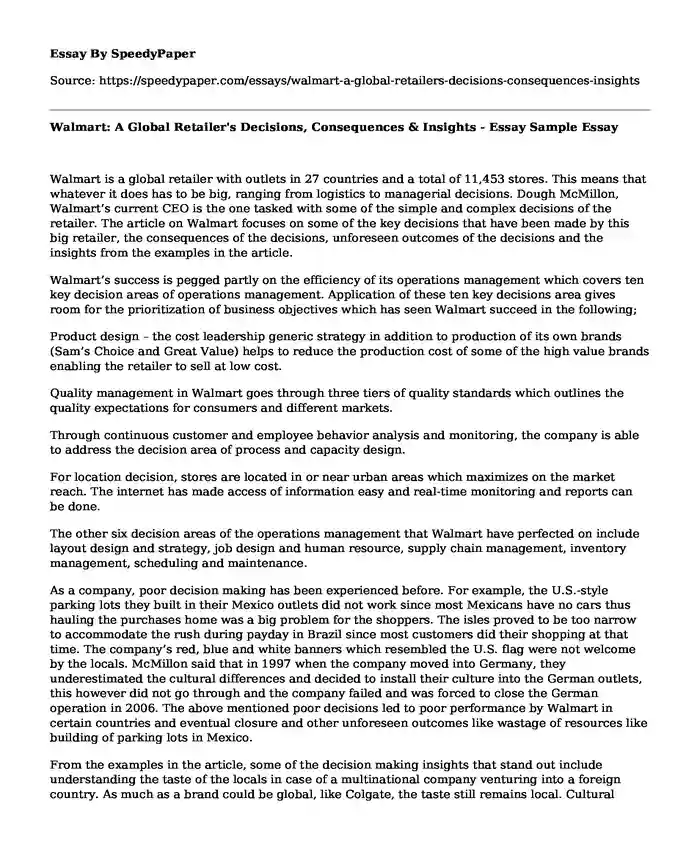Walmart is a global retailer with outlets in 27 countries and a total of 11,453 stores. This means that whatever it does has to be big, ranging from logistics to managerial decisions. Dough McMillon, Walmart’s current CEO is the one tasked with some of the simple and complex decisions of the retailer. The article on Walmart focuses on some of the key decisions that have been made by this big retailer, the consequences of the decisions, unforeseen outcomes of the decisions and the insights from the examples in the article.
Walmart’s success is pegged partly on the efficiency of its operations management which covers ten key decision areas of operations management. Application of these ten key decisions area gives room for the prioritization of business objectives which has seen Walmart succeed in the following;
Product design – the cost leadership generic strategy in addition to production of its own brands (Sam’s Choice and Great Value) helps to reduce the production cost of some of the high value brands enabling the retailer to sell at low cost.
Quality management in Walmart goes through three tiers of quality standards which outlines the quality expectations for consumers and different markets.
Through continuous customer and employee behavior analysis and monitoring, the company is able to address the decision area of process and capacity design.
For location decision, stores are located in or near urban areas which maximizes on the market reach. The internet has made access of information easy and real-time monitoring and reports can be done.
The other six decision areas of the operations management that Walmart have perfected on include layout design and strategy, job design and human resource, supply chain management, inventory management, scheduling and maintenance.
As a company, poor decision making has been experienced before. For example, the U.S.-style parking lots they built in their Mexico outlets did not work since most Mexicans have no cars thus hauling the purchases home was a big problem for the shoppers. The isles proved to be too narrow to accommodate the rush during payday in Brazil since most customers did their shopping at that time. The company’s red, blue and white banners which resembled the U.S. flag were not welcome by the locals. McMillon said that in 1997 when the company moved into Germany, they underestimated the cultural differences and decided to install their culture into the German outlets, this however did not go through and the company failed and was forced to close the German operation in 2006. The above mentioned poor decisions led to poor performance by Walmart in certain countries and eventual closure and other unforeseen outcomes like wastage of resources like building of parking lots in Mexico.
From the examples in the article, some of the decision making insights that stand out include understanding the taste of the locals in case of a multinational company venturing into a foreign country. As much as a brand could be global, like Colgate, the taste still remains local. Cultural differences should also never be ignored and products should be tailored to meet the cultural expectations of the locals.
The economic capacity of the market should also be studied so that the designs and layout of the business favors their transport means, like in the case of Mexico. Employing locals and giving them the necessary training is a good strategy of getting established in a given market since they have information about the tastes and expectations of the customers. This means that it is also important to involve employees in decision making especially those to do with branding, product design and layout design. All in all, good decision making is a crucial component of a company’s success and should be thought through with consideration of the prevailing factors if any success is to be realized.
References
Smithson, N. (2017). Walmart: Operations Management 10 Decisions, Productivity - Panmore Institute. Panmore Institute. Retrieved 16 August 2020, from http://panmore.com/walmart-operations-management-10-decisions-areas-productivity-case-study-analysis.
Cite this page
Walmart: A Global Retailer's Decisions, Consequences & Insights - Essay Sample. (2023, Nov 12). Retrieved from https://speedypaper.com/essays/walmart-a-global-retailers-decisions-consequences-insights
Request Removal
If you are the original author of this essay and no longer wish to have it published on the SpeedyPaper website, please click below to request its removal:
- Free Essay: Strategic Management Exam Questions and Answers
- Walmart's Wellness Program - HRM Essay Example
- Paper Example on Data Ethics Issues in Big Data Intelligence for Banks
- Products and Branding. Free Essay
- Investment Project to Start After Completion of Schooling. Free Essay
- Pros and Cons of Social Media for Promotion - Essay Example
- Essay Sample on Golden Arches Brilliance: Analyzing McDonald's Branding and Video Advertisements
Popular categories





